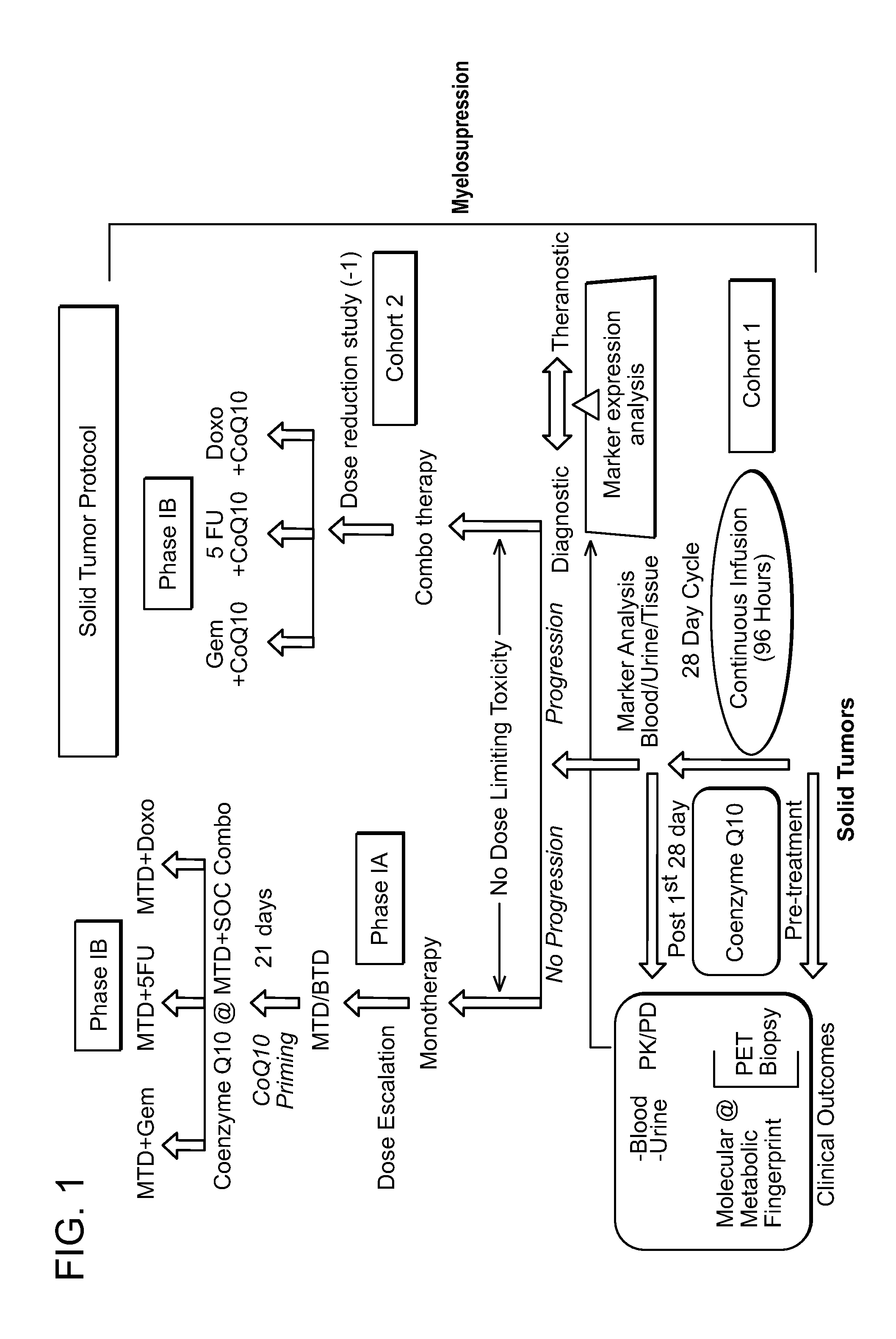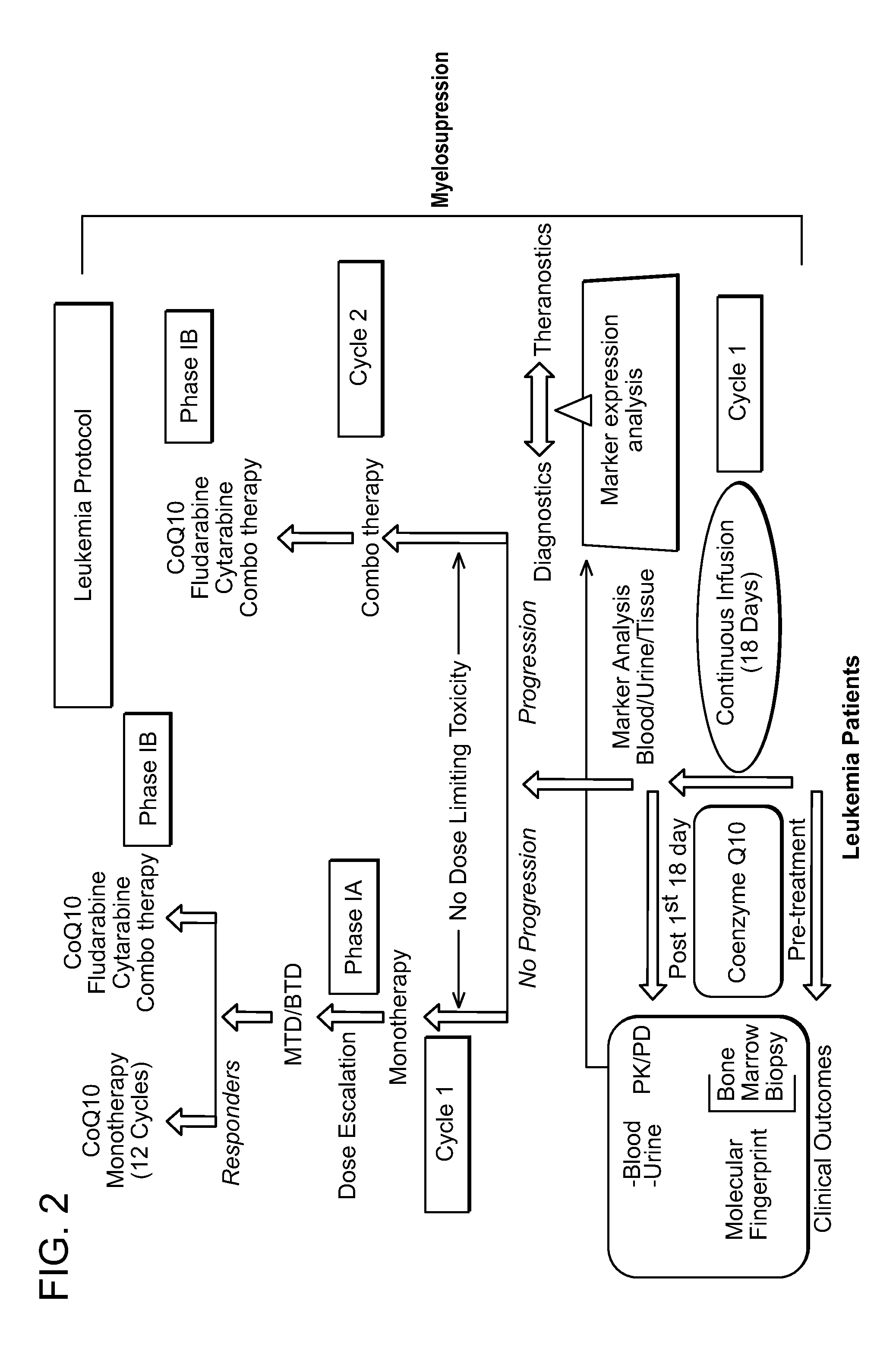Methods of treatment of cancer by continuous infusion of coenzyme q10
a coenzyme q10 and cancer technology, applied in the direction of drug compositions, peptide/protein ingredients, extracellular fluid disorders, etc., can solve the problems of cancer patients suffering from cancer, losing effectiveness, and chemotherapeutic agents used in cancer treatment are known to produce several serious and unpleasant side effects in patients, and achieve the effect of reducing the number of side effects
- Summary
- Abstract
- Description
- Claims
- Application Information
AI Technical Summary
Benefits of technology
Problems solved by technology
Method used
Image
Examples
example 1
Parenteral Coenzyme Q10 Formulation Significantly Improves Survival in Animal Model of Leukemia Including the Resolution of Paraplegia Due to Brain Metastasis
[0456]Leukemia cells exhibit alterations in intermediary metabolism similar to other cancers, wherein ATP sourcing is shunted from mitochondrial oxphos towards glycolytic preponderance (Warburg Effect) to meet oncogenic proliferative demands. A consequence of this metabolic switch is the simultaneous short-circuit of the programmed death pathways, leading to a immortalization program in cancer cells including leukemia. Delivery of high levels of coenzyme Q10 in a lipid nanodispersion mixture has been demonstrated to preferentially shift metabolic networks from glycolysis towards mitochondrial-centric oxphos and recapitulation of apoptotic pathways in various cancers in vitro and in vivo models. Given the centrality of the Bcl-2 involvement in the etiology of leukemia, this study focused on investigation of the effectiveness of ...
example 2
Coenzyme Q10 Treatment Reduces Viability of Various Cancer Cells in Vitro
[0467]Various cancer cell lines were treated with coenzyme Q10 at 100 μM concentration to determine the effect on cancer cell viability. The cancer cell lines tested were HT-29 (colon), A549 (lung), Hep3B (liver), MDA-MB231 (breast), SkBr-3 (breast), MCF7 (breast), MiaPaCa-2 (pancreas), SKOV-3 (ovary), and PC-3 (prostate). Cell viability was measured between 24 and 72 hours. In all cancer cell lines tested, a decrease in cell viability in response to coenzyme Q10 was evident as early as 24 hours and increased progressively between 48 and 72 hours. For example, FIG. 6 shows cell viability with and without coenzyme Q10 treatment at 48 hours of exposure (for cell lines HT-29, A549, Hep3B, MDA-MB231, SkBr-3 and BT549) or 72 hours of exposure (for cell lines MCF7, MiaPaca-2, SKOV-3, and PC-3). The text at the bottom of the graph in FIG. 6 represents the gene mutation and mutation rate for each cell line. For example...
example 3
Continuous Infusion of Coenzyme Q10 Improves Survival in Animal Models of Pancreatic, Prostate, and Lung Cancer
[0469]Several studies were undertaken to determine the effect of different dosing regimens of a coenzyme Q10 nano suspension formulation on animal survival in animal models of various cancers.
[0470]For example, FIG. 7 is a schematic describing a study investigating three different dosing regimens for coenzyme Q10 in an animal model of pancreatic cancer. The effect of coenzyme Q10 alone or in combination with gemcitabine on total survival in a preclinical mouse model of pancreatic cancer was evaluated.
[0471]Equal numbers of MIAPaCa-2 human pancreatic tumor cells were suspended in MATRIGEL® and injected into NOD scid gamma (NSG) mice. The NSG mouse model is devoid of innate and adaptive immune systems and provides a biological environment suitable for the growth of human tumors in vivo. The MIAPaCa-2 is a well established human derived pancreatic carcinoma cell line that can ...
PUM
| Property | Measurement | Unit |
|---|---|---|
| time | aaaaa | aaaaa |
| time | aaaaa | aaaaa |
| time | aaaaa | aaaaa |
Abstract
Description
Claims
Application Information
 Login to View More
Login to View More - R&D
- Intellectual Property
- Life Sciences
- Materials
- Tech Scout
- Unparalleled Data Quality
- Higher Quality Content
- 60% Fewer Hallucinations
Browse by: Latest US Patents, China's latest patents, Technical Efficacy Thesaurus, Application Domain, Technology Topic, Popular Technical Reports.
© 2025 PatSnap. All rights reserved.Legal|Privacy policy|Modern Slavery Act Transparency Statement|Sitemap|About US| Contact US: help@patsnap.com



